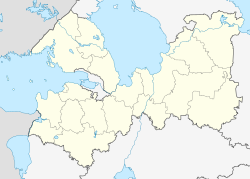Sosnovy Bor sanatorium
| place
Sanatorium Sosnovy Bor
Санаторий Сосновый Бор
|
||||||||||||||||||||||||||
|
||||||||||||||||||||||||||
|
||||||||||||||||||||||||||
Sanatorium Sosnowy Bor ( Russian Санаторий Сосновый Бор , literally Sanatorium Kiefernwald ), until 1949 Sanatorium Halila (Халила, Chalila ), is a Russian settlement northwest of Saint Petersburg in Vyborg district of Leningrad Oblast . The village consists of a tuberculosis clinic as well as the associated infrastructure buildings and the residential buildings for the staff.
location
The village is about 60 kilometers south of Vyborg . The sanatorium, located in a large pine forest , is around five kilometers from the next major road A125 and around eight kilometers from the next town Poljany (fin. Uusikirkko).
history
For the treatment of tuberculosis patients, sanatoriums were established and operated mainly in the mountain and foothills regions from the mid-19th century. Several such clinics were created in the Crimea and in the Caucasus .
Contrary to popular views on the situation of such a sanatorium for the doctor Vladimir of Dittmann opened on June 1, 1889 in the forest area between Saint Petersburg and Vyborg on the corridor of the Karelian village Halila the private sanatorium Halila. The two-story sanatorium building had 34 rooms and could accommodate 16 to 20 tuberculosis patients. Due to the lack of success in terms of utilization of the clinic, Dittmann ceased operations on November 15, 1891. The sanatorium was then on December 23, 1891 by Tsar Alexander III. purchased for 100,000 gold rubles .
As a result, the sanatorium building was expanded to accommodate 30 more patients. The building received electrical lighting and a connection to the water supply. In addition, an Orthodox church was built for Alexander Nevsky . The wooden church burned down later and was built as a stone building from 1905 to 1907. From 1925 this was also used for Evangelical Lutheran church services.
A second building for 24 patients was built in 1894 to treat students from Tsarina Maria's educational institutions . This was named after the tsarina.
On the initiative of Tsarina Alexandra Feodorovna , the sanatorium was expanded again in 1895 with financial means from Tsar Nicholas II . The Nikolaus-Bau was opened in August 1897. This building initially offered space for 50 patients. These places were primarily intended for officers of the Navy and the Guard from St. Petersburg. Later the capacity was increased to 90 places, 50 of which were reserved for officers.
In 1912 a total of 445 patients were treated. Over time, the demand for appropriate sanatorium places increased so that soon the demand could no longer be satisfied. That is why the "New Alexander Department" was established from 1913 to 1915. The building, which was built according to plans by the government architect Allan Carl Waldemar Schulman , offered space for the treatment of 90 women.
In addition to the four sanatorium buildings, other buildings were built on the 500 hectare hospital grounds. In addition to residential buildings for staff and doctors, there was a post office, a power station, a water tower, a fire station , a laundry, a hotel, a quarantine station, a school and various garages, storage and storage buildings. The drinking water for the system is filtered from a nearby lake and transported to the sanatorium by pumps. The economy of the nearby village of Halila was entirely geared towards supplying the sanatorium. In 1920 over 780 children from Petrograd were housed in the sanatorium, who were cared for by the American Red Cross.
In 1920 the sanatorium came to Finland . The Maria-Bau and the older Alexander-Bau were no longer used due to the inadequate hygienic standards. The Grand Duchess Xenija Alexandrovna Romanowa sued the Finnish state for compensation, which was paid to her in 1933 in the amount of 15,000 pounds sterling after a court settlement. Until 1940 the clinic served as a public hospital in Finland. On the basis of Article 30 of the Dorpat Peace Agreement between Finland and the Soviet Union of 1920, half of the beds in the sanatorium were available to residents of Petrograd and the surrounding area until 1930.
During the Second World War the sanatorium served as a hospital for Finnish and Soviet soldiers. The Maria Building and the Nikolaus Building were destroyed during the war. Treatment for tuberculosis was resumed after the end of the war. In 1949 the sanatorium was renamed from “Halila” to “Sosnovy Bor”.
From 1976 a new staff apartment block with 100 apartments was built. The cultivation of agricultural products began to take care of the patients. In addition, the four-kilometer access road was paved, a sewage treatment plant was built and the Orthodox church was renovated.
The sanatorium has been an independent village since 1987. The clinic has 300 beds and a staff of 200 people.
On July 26, 1995, the clinic was renamed “Sosnovy Bor City Sanatorium”. The clinic has since been renovated and expanded. The still existing New Alexander Department is a listed building.
sanatorium
The sanatorium is now under the administration of the city of Saint Petersburg. Currently around 2000 tuberculosis patients from the city of Saint Petersburg and Leningrad Oblast are cared for each year.
Various therapeutic and diagnostic methods are used in the clinic. Chemotherapy, physiotherapy, brine, light and air treatments are offered. In addition, the sanatorium offers special dietary meals.
Web links
- Sanatorium website, including extensive history
- ristikivi.spb.ru: Halila / Халила / Сосновый Бор
- terijoki.spb.ru: Сосновый Бор (Халила)
Individual evidence
- ↑ Nomination of Paimio Hospital for Inclusion in the World Heritage List, Helsinki 2005, p. 21.
- ↑ "Нива" №35 за 1889 г.
- ↑ http://ristikivi.spb.ru/albums/halila-church-old.html
- ↑ http://ristikivi.spb.ru/albums/halila-church.html
- ^ Margaret Houghton: The Hamiltonians , James Lorimer Company, 2003, p. 57.
- ↑ Rauhansopimus Suomen Tasavallan ja Venäjän Sosialistisen Federatiivisen Neuvostotasavallan välillä
- ↑ cultnadzor.ru: Санаторий "Халила"



